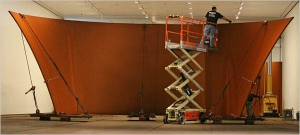 Having read Serra’s book of writings and interviews, and having watched and listened to the long interviews and discussions spawned by this retrospective and other recent exhibitions, I went to the MoMA discussion last night assuming I would hear nothing new. I was wrong.
Having read Serra’s book of writings and interviews, and having watched and listened to the long interviews and discussions spawned by this retrospective and other recent exhibitions, I went to the MoMA discussion last night assuming I would hear nothing new. I was wrong.
Serra is an exceptionally thoughtful man who takes even the most conventional questions seriously, i.e. as an opportunity to think through a situation or engage with an idea as if he were confronting it for the first time. He turns the conversation around, Serra-style, on his own terms and makes it an “event” in the Deleuzean sense of the term, avoiding at all cost the media-event or spectacle.
He said he doesn’t like doing too many interviews, particularly around occasions such as the retrospective, because it tends to encourage a debilitating self-consciousness and repetition. There’s a hidden danger in taking yourself as the subject of investigation and viewing your work from the outside, particularly in public. This practice of disengagement, done too often and over a long period of time, can distort your relation to and involvement in your work.
So, what we saw was Serra at work.
When asked if there was anything new that occurred to him during the course of the MoMA show, he said the one thing he noticed in this and his other recent exhibitions was “people gathering to see the work together”. He didn’t elaborate but I take it he was impressed by the combination of pleasure and collective fascination viewers experience as they walk around and through Band, Torqued Torus Inversion, and Sequence. There’s a perceptual and intellectual curiosity induced, particularly by these large steel works, which gives rise to questions, observations, and discussions. That happens less and less frequently in exhibitions of contemporary art.
Serra noted, perhaps with a touch of disparagement, that when he became involved in the arts, museums were experienced as either banks or churches. The placement of this statement suggested that the reception of the work at MoMA was a welcome change. While I’m inclined to think that the scale and force of his recent work both promotes and benefits from a return to the “reverence” and respect required in a church, there may be something different going on here. Serra and MoMA have created a high-brow “Exploratorium” for the viewer. And I say that without irony or criticism. There is no photography allowed in the galleries. You don’t have the distracting and annoying cell-phone photo-tourism going on around you. You’re there to walk and look at the work—nothing else. It’s a controlled public space which approaches ideal viewing conditions. This makes it more likely that you’ll engage the work as Serra does. You sense the weight—”how your body senses weight”—and, at the same time, the non-material realization, geometrical elegance, and grace of these objects. They make present what Serra refers to as “the concentration of mass” and “substance of the void”. And then the “skin”. “When the weight gets to the skin, it really becomes weightless.”
